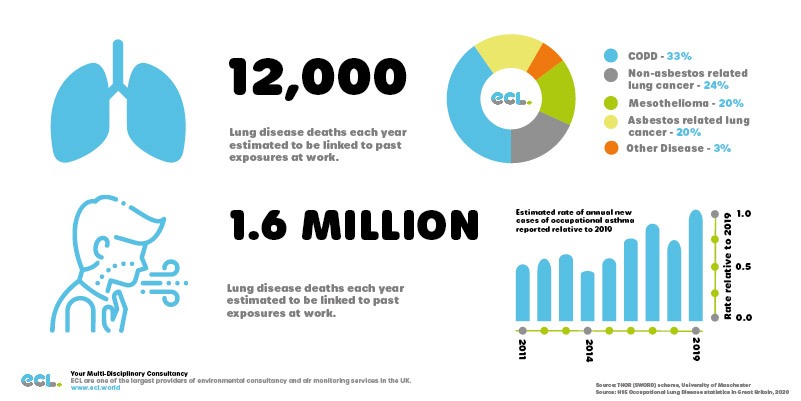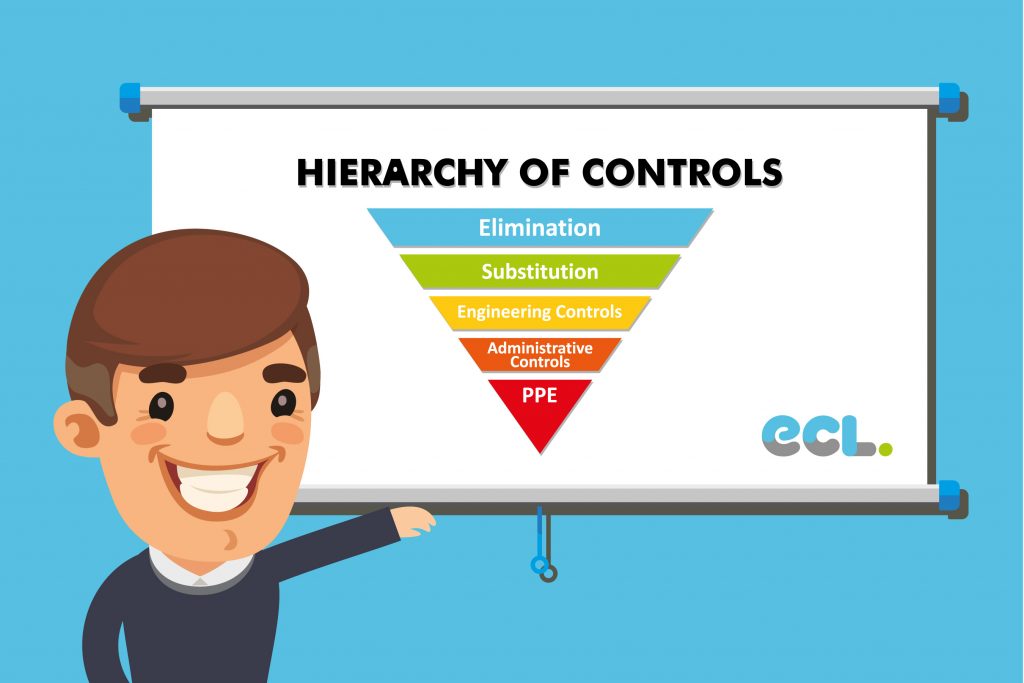The question ‘What is COSHH?’ arises often when speaking to many new smaller businesses who come to us to improve the overall workplace health and safety in their company, or for help navigating their way to providing a safe working environment for their staff and to maintain compliance with current regulations.
So much so, our consultants thought they would create a series of informative articles to easily explain what COSHH is, the potential risks involved, what the process entails and why COSHH Air Monitoring and COSHH compliance is so important for all businesses.

What Is COSHH?
In short, COSHH, which is an acronym for the ‘Control of Substances Hazardous to Health’ is a law that requires all UK employers to prevent, control, or drastically reduce the exposure to any potentially hazardous substances in the workplace that may affect the health and well-being of their employees, themselves, or the public.
The Control of Substances Hazardous to Health Regulations laid down by The HSE back in November 2002, makes it mandatory in the UK for all employers, regardless of industry or size, to comply with these health and safety laws and outlines general requirements to protect both workers and employees from the hazards of these substances via effective health surveillance, risk assessments, training, incident planning and overall control of exposure.
Most companies and organisations in the UK are increasingly using various substances that could cause harm to contractors, or on-site staff, with around 25% of workers being exposed in some way. This is why these regulations are more important than ever.
COSHH covers a vast array of substances hazardous to health, that come in many different forms, from: Chemicals, to Dusts (Silica Dust), to fumes (Welding Fumes) to mists (metalworking mist & oil mists) to vapours (paint solvents & other Volatile Organic Compounds VOCs), to gases (carbon monoxide & nitric oxide), to biological agents (COVD-19 & Legionella). How these substances are used, and the conditions may affect the form in which these substances appear.
Why Is COSHH Compliance Important?
In 2019/20 the HSE recorded that over 1.6 million workers were suffering from work-related ill-health (new or long-standing).
The HSE also estimates over 12,000 lung disease deaths each year linked to past exposures at work. Of these 12,000, 44% resulted from lung cancer and 33% from chronic obstructive pulmonary disease (COPD).

There are hazardous substances in almost all work environments around the world, with millions of workers in close proximity to or exposed on a daily basis.
While the health and safety of human life is always the primary concern, the financial cost to a business can also be very large. In 2018/19 over 31 million working days were lost due to workplace injury.
Companies that adhere to the COSHH Regulations not only save money by reducing absenteeism but become far more effective in terms of not having to replace and retrain skilled workers.
What Do The COSHH Symbols Mean?
The new COSHH symbols were introduced as per CLP Regulations in 2009.
There are a total of nine primary new COSHH symbols located on packaging of hazardous substances.
The purpose of the nine red and black diamond symbols below is to warn the user about the type of hazard a substance presents. They were created to be universal and are successfully understood and used in most countries around the world.
The names below are not official names given to each symbol, as each symbol actually has a wider range of meanings:

- Long-Term Health Hazards – This symbol indicates that a substance has the potential to cause serious and long term damage to health and contain the presence of carcinogenic agents or substances with respiratory, reproductive or organ toxicity.
- Explosive – The exploding bomb symbol indicates that a substance is an unstable explosive and may mass explode in fire.
- Toxic – The toxic symbol indicates a substance can cause damage to health even at very low levels of exposure. It may be fatal if a toxic substance is inhaled, swallowed or comes into contact with skin.
- Flammable – The flame symbol indicates that a substance may catch fire with very brief contact with air or ignition source. It could also have a very low flash point or evolve highly flammable gases in contact with water.
- Warning – The exclamation mark symbol, also referred to as ‘Caution’ or ‘Health Hazard’ relates to slightly less hazardous substances that may not pose an immediate or severe threat to health but should always be handled within the workplace carefully.
- Oxidising – The flaming ball symbol represents substances and preparations that react exothermically with other chemicals and may cause a fire, combust or explode.
- Corrosive – The corrosion symbol indicates that a substance that can damage or destroy other substances with which it comes into contact. These chemical reactions can damage materials, destroy living tissue, cause severe burns and serious eye damage.
- Compressed Gas – This symbol indicates that gas is stored under pressure, such as in gas containers. Compressed gas can be a very hazardous substance. If a tank isn’t properly maintained or is heated, it may explode. On the other side, cold compressed gas can also cause very serious skin burns.
- Danger To The Environment – The dead fish symbol indicates a substance that may present an immediate or delayed danger to aspects of the environment, such as aquatic life, wildlife, plant life or people.
How To Comply With COSHH Regulations
COSHH regulations will most probably apply to your company, regardless of industry. This is because almost all businesses, even those in less dangerous industries, still use harmful substances that can be a danger to employees.
IDENTIFY AND ASSESS
In order to identify and assess the risks from hazardous substances in the workplace and comply with current regulation, companies may be required to conduct a COSHH risk assessment as a first step towards COSHH compliance.
Identifying the hazards in the products used in your business is often simple, as almost all products will now have the COSHH symbols detailed earlier in this article, located on the packaging somewhere to outline if they are hazardous or not. In any case, suppliers have a duty to provide all necessary hazard information for any / all materials (usually in the form of Material Safety Data Sheets (MSDS)).
To identify hazards in your workplace, take a look around your premises, consider all equipment and processes that produce hazardous substances.
Once you have identified all the risks, you can record how likely your findings are to cause harm, and if any tasks relating to them may lead to exposure. Ask questions like:
- How might contractors or employees be exposed?
- Could an employee potentially inhale any dusts, gases, or fumes?
- Does a substance have the potential to damage a person’s skin, even through PPE?
- Is there potential to be exposed via transferring chemicals from hands to mouths or eyes after handling a chemical or coming away from a process?
PREVENT OR REDUCE
Preventing, or at the very least reducing, exposure to hazardous substances is one of the main requirements for COSHH Compliance. Remember, preventing exposure to hazardous materials will provide an overall safer workplace and in more likely to prevent further accidents.
One of the most significant ways of preventing exposure to hazardous substances in the workplace is to consider substituting or using an alternative substance that presents much less of a health risk.
Supervising a workforce or process is another method of prevention that can be used, as employers can be assured all health and safety procedures are followed. This method should also prevent other COSHH related incidents.
If prevention of exposure is not reasonably practicable and all measures have been put in place to attempt to reduce exposure, control methods should then be implemented.
CONTROL AND MONITOR
The use of Control equipment can further drastically reduce the exposure to airborne hazards and can greatly reduce the risk of contamination when working alongside dangerous substances.
Different types of control systems include: Local Exhaust Ventilation (LEV) systems, decontamination equipment and of course, when its exposure is practically unavoidable, Personal Protective Equipment (PPE) should always be provided when working with hazardous substances but should always only be considered the last control measure applied.
Types of PPE include: Protective gloves, hard hats, respirators, footwear, and protective eyewear.
Once all relevant control measures have been put in place within the organisation, to obtain COSHH compliance all employers are then (as per COSHH regulation 10) required to monitor the effectiveness of these applied measures.
There are various different methods of workplace exposure monitoring that can be used, such as the testing for the presence of bacteria on work surfaces, workplace air monitoring and of course, the recording of any injuries or accidents that occur despite the current control measures in place.
It is a continual requirement for all employees to always be properly supervised, trained, and informed (COSHH regulation 12).

What Are COSHH Workplace Exposure Limits?
EU Indicative Limit Values or to give them their full name, Indicative Occupational Exposure Limit Values (IOELVs) are health-based limits set under the Chemical Agents Directive (98/24/EC)
IOELVs will be either identical or remarkably close to British limits. British limits are called Workplace Exposure Limits (WELs).
WELs are applied to hazardous substances in the air, averaged over a specified period of time and referred to as a time-weighted average (TWA). Typically, this is eight hours, but short-term exposure periods of 15 minutes are also assigned limit values.
Another place to find resource and information about relevant workplace exposure limits is via the Materials Safety Data Sheets (MSDS), which should be provided to you free-of-charge, on paper or electronically.
Material Safety Data Sheets contain technical information to enable you to produce a COSHH Assessment and should contain the following information:
- Identification of the substance/mixture and of the company/undertaking
- Hazard identification
- Composition/information on ingredients
- First-aid measures
- Fire-fighting measures
- Accidental release measures
- Handling and storage
- Exposure control/personal protection
- Physical and chemical properties
- Stability and reactivity
- Toxicological information
- Ecological Information
- Disposal considerations
- Transport information
- Regulatory information
- Any other relevant information
Stages To Complete COSHH Compliance
To summarise, the responsibilities of COSHH essentially fall on the employer.
To continue to comply with the COSHH Regulations, as an employer you must make sure to assess the overall risks to health that could potentially arise from hazardous substances from work activities undertaken, and further decide which dmeasures can be used in order to prevent or adequately control exposure.
Employers should ensure monitoring is undertaken when processes are changed or of course new ones added, as well as keep all COSHH risk assessments up to date.
- COSHH Risk Assessment.
- Decide the required precautions.
- Prevent or adequately control exposure.
- Ensure maintenance of control measures.
- Monitor exposure.
- Carry out Health Surveillance.
- Prepare emergency procedures.
- Ensure all employees are adequately trained.
ECL offer Workplace Exposure Monitoring and COSHH Risk Assessment services to monitor air quality at work.
Our consultants are members of the British Occupational Hygiene Society (BOHS) and can also offer you a thorough examination and testing of your control measures including local exhaust ventilation testing, workplace air monitoring and Workplace Noise Assessments.
We also provide a full detailed report on work practices and findings together with recommendations for remedial action.
Contact us via our Enquiry Form or call us on 01443 841 760 for any queries regarding our wide range of Occupational Hygiene services or COSHH compliance.

